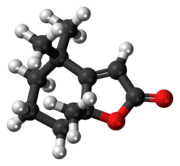Dihydroactinidiolide
 |
|
 |
|
| Names | |
|---|---|
|
IUPAC name
(7aR)-5,6,7,7a-Tetrahydro-4,4,7a-
|
|
| Other names
Dihydroactinidiolide
|
|
| Identifiers | |
|
3D model (JSmol)
|
|
| ChemSpider | |
| ECHA InfoCard | 100.169.249 |
|
PubChem CID
|
|
|
|
|
|
| Properties | |
| C11H16O2 | |
| Molar mass | 180.24 g/mol |
|
Except where otherwise noted, data are given for materials in their standard state (at 25 °C [77 °F], 100 kPa).
|
|
|
|
|
| Infobox references | |
Dihydroactinidiolide is a volatile terpene. It has a sweet, tea-like odor and is used as a fragrance. Dihydroactinidiolide occurs naturally in black tea, fenugreek, fire ants, mangos, silver vine (Actinidia polygama), and tobacco. It has also been prepared synthetically.
Dihydroactinidiolide is a pheromone for a variety of insects; for example, it is one of the three components of the pheromone for queen recognition of the workers of the red fire ant.
As with nepetalactone, found in catnip, dihydroactinidiolide is a cat attractant. Cultivators of silver vine (which contains another such chemical, actinidine, which is also a cat attractant) sometimes find their plants destroyed by enthusiastic cats.
...
Wikipedia
